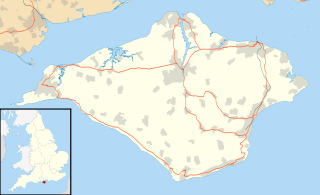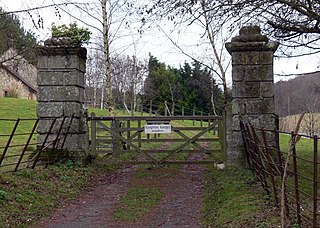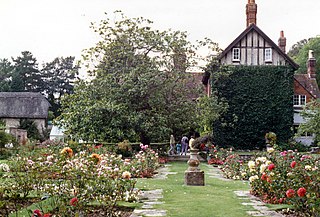
Sandown is a seaside resort and civil parish on the south-east coast of the Isle of Wight, United Kingdom with the resort of Shanklin to the south and the settlement of Lake in between. Together with Shanklin, Sandown forms a built-up area of 21,374 inhabitants.

Yaverland is a village on the Isle of Wight, just north of Sandown on Sandown Bay. It has about 200 houses. About 1⁄3 of a mile away from the village is the Yaverland Manor and Church. Holotype fossils have been discovered here of Yaverlandia and a pterosaur, Caulkicephalus. The White Air extreme sports festival was held annually at Yaverland pay and display car park between 1997 and 2008, but moved to Brighton for 2009.

The House of Gorges is an ancient English family with Norman origins. They obtained the manors of Wraxall, Somerset and Bradpole in Dorset. The family again reached prominence in the 16th and 17th centuries.

Sir William Russell (1257–1311) was an English nobleman, knight, and holder of a moiety of the feudal barony of North Cadbury, Somerset, but spent most of his life engaged in the administration and defence of the Isle of Wight, where he obtained by marriage the manor of Yaverland. He served as constable of Carisbrooke Castle, and sat in parliament on two occasions, firstly as burgess for Great Bedwyn, Wiltshire, and then for the County of Southampton. As a baron his military service was called on several times by King Edward I Hammer of the Scots.

Knighton Gorges Manor was one of the grandest manor houses on the Isle of Wight. Located in the hamlet of Knighton, near Newchurch, it is reported to be one of the most haunted locations on the Isle of Wight.

Morton Manor is a manor house originating in the 13th century, in Brading, Isle of Wight, England. It is located 1 mile (1.6 km) southwest of Sandown Road. The 14th century fairly small house was modified in the 19th century. Constructed of varied materials, it was refurbished and extended in the early 20th century in an Arts and Crafts style. A Tudor fireplace is in the dining room, with William De Morgan green glazed tiles. The manor includes a small museum of rural life.
Branston Manor is a manor house on the Isle of Wight, situated within the Newchurch parish.
Merston Manor is a manor house in Merstone on the Isle of Wight, England. The manor was first mentioned in the Domesday Book. Prior to the Norman Conquest, Merston Manor was owned by the Brictuin family. The present home, built in 1605 in the Jacobean style by Edward Cheeke, was rebuilt in the Victorian era. This structure may be the oldest brick house on the Island. The manor now belongs to the Crofts family.
Billingham Manor is a manor house lying about a mile south of the village of Chillerton on the Isle of Wight.
Briddlesford Manor, is a manor house on the Isle of Wight, situated in the parish of Arreton.
Appley House is an English country house and abbey in Appley Rise, Ryde, Isle of Wight.

Westcourt Manor is one of three manor houses, along with Woolverton and Northcourt, that is located in Shorwell, on the Isle of Wight, England. According to the Domesday Book, it was part of the possessions of Gozehne Fitz Azor, and had been held in the time of the Edward the Confessor by Ulnod in abeyance. At the time of the countess Isabella's record, we find that Sir John Lisle had this manor, with many others, which he held of her in capite, or by knight's service. It was possessed by Colonel Hill. An Elizabethan manor, it is connected to a farm of 200 acres.
Thorley Manor is a manor house just outside Yarmouth, on the Isle of Wight, England. Built in 1712, it features a modillion cornice, hipped roof, as well as tall chimneys.

Sheat Manor is a manor house in Chillerton, on the Isle of Wight, England. Considered to be one of the island's antiquities, Sheat manor house, is a fine old gabled mansion now used as a farmhouse. It has a pond and swans. It contains some interesting Jacobite carving. Sheat was one of the few properties whose Anglo-Saxon owner, Alaric, was not disturbed by the Norman invasion. It was run by the Urry family for some time.
Horringford Manor is a manor house on the Isle of Wight, situated in the parish of Arreton.

Landguard Manor is a manor house in Shanklin on the Isle of Wight, England. Mentioned in the Domesday Book, over the centuries it was home to numerous notable gentlemen. It is a Grade II listed building. One of the finest known portraits by Sir Thomas Lawrence, English portrait painter and president of the Royal Academy, is located in its drawing room.
Park Manor is a manor house in the parish of Brading on the Isle of Wight.
Rowborough Manor is a manor house in the parish of Brading on the Isle of Wight.
Sandown Manor is a manor house in the parish of Brading on the Isle of Wight.
The Manor of Dyrham was a former manorial estate in the parish of Dyrham in South Gloucestershire, England.









